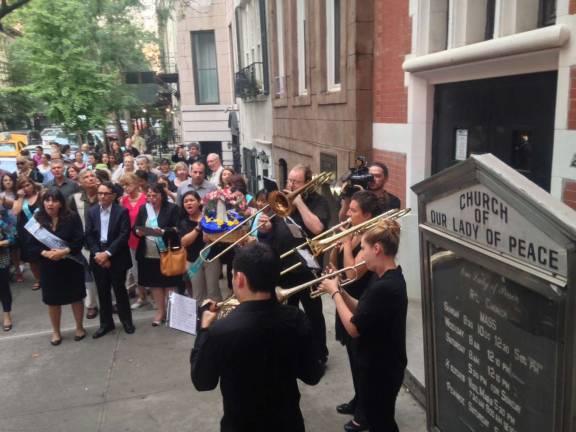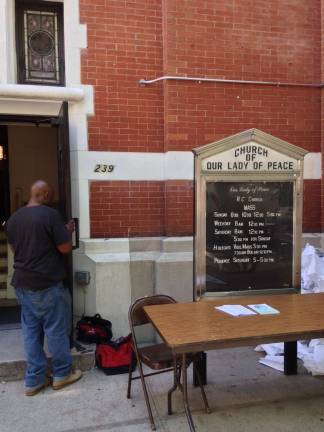The last days of Our Lady of Peace



Nearing their 30-year anniversary, Janice Dooner Lynch and Tom Lynch renewed their marriage vows last week inside a red brick church with neat white stone trim on a tidy Upper East Side block.
It was a bittersweet occasion.
“We did it today, the last day we could possibly do it,” Janice Lynch said a few hours after the church's pastor, the Rev. Bartholomew Daly, officiated at the ceremony July 30.
It would be among Daly's last official acts as pastor of Our Lady of Peace on East 62nd Street. After nearly 100 years as a parish, the church's doors closed, likely for good, the following day.
The Catholic parish, established in 1919 by a growing population of Italian immigrants to the city and the neighborhood, was one of dozens shuttered by the Archdiocese of New York, which cited declining attendance, shifting demographics and a shortage of priests, among other factors, when it announced closings of parishes stretching from Staten Island to Albany late last year. Officially, Our Lady of Peace merged with that of Saint John the Evangelist, seven blocks to the south, to create an entirely new parish on Aug. 1.
Beginning with her grandmother in 1921, four generations of Lynch's family passed under the marble archway leading into to the church and on which the words “Domus Dei et Porta Coeli” — God's House and Heaven's Door — are carved.
Like her parents and grandparents, she and her husband were married there, in October 1985. Her daughter, Kellie, was baptized at the church.
“You feel the family's history being ripped out,” Lynch said.
Congregants said they were confounded by the archdiocese's decision to close Our Lady of Peace since, they said, the parish was financially sound, so much so that a $450,000 renovation in 2008 and 2009 was paid for entirely by the congregation.
“This church has been in the black for years,” Lynch said, adding that the congregation's numbers, while holding steady at about 400, was likely to grow. “It owes no debt to anyone. As a result it shouldn't be closed.”
Many said they expected the church to be sold to developers, despite the fact that it is within the Treadwell Farm Historic District and that a covenant dating the 1860s would restrict development efforts.
But a spokesman for the Archdiocese, Joseph Zwilling, said the archdiocese could not in and off itself sell the building. “It will be up to the new parish to determine what the next steps will be,” he said. “It is the property of the new parish. They will have to come to a decision about what will happen.”
Diocesan officials would only “focus” and “guide” the parish toward any decision about the building, Zwilling said.
“They may come to a decision 'we'd like to sell this,'” he said. “They may decide to use it for some other church-related purpose.”
If there was resentment about the Archdiocese's decision, though, there was also hope.
Lynch and several other parishioners have submitted five volumes of documentation, including financial records, to the Vatican in the hopes of overturning the Archdiocese's decree. A decision is due sometime after Sept. 1, she said.
Our Lady of Peace, Lynch said, was a hub of comfort and continuity at a time when respect and reverence for history and tradition are at an ebb. The church's closing is yet another symptom of that tendency, she said a few minutes before dozens of congregants accompanied by a four-piece brass ensemble playing the Lourdes Hymn began a Rosary Procession July 30. They walked down Second Avenue, along 61st Street and up Third Avenue before turning back onto 62nd Street, passing under scaffolding, apartment renovations and a condominium conversion project along the way.
The procession prefaced an all-night vigil to commemorate the parish's nearly 100 years of history, the marriages, baptism and funerals that took place there.
Before evening Mass, Estela Ojeda, a 22-year congregant, said the church was home to a charismatic and dedicated congregation from all corners of the world. Ojeda, a former resident of the neighborhood who moved to Queens but nevertheless led prayer meetings on Thursdays and attended Mass on Sundays, said the diocese neglected to take the parish's pulse before deciding to close it.
“This is a community. We know each other,” she said as the church's organ tones swelled above the roughly 120 people in the pews. “It's a family, more than blood relatives.”
By Friday morning, lit candles, burning overnight, had dripped wax on the church's stone steps and parishioners ambled outside trading embraces. Before a Solemn Mass, the parish's last, a locksmith worked to change the locks on the church's doors.
Daly, the church's pastor for 22 years, called the church's congregation inclusive and welcoming, and a full reflection of the generations of immigrants — whether German, Italian, Irish and, lately, Asian and South and Central American — that lent the parish its dynamism.
“It's a place where all religions find peace,” said Daly, who will move to a parish in Westchester County. “Hopefully they will bring that spirit to other parishes.”